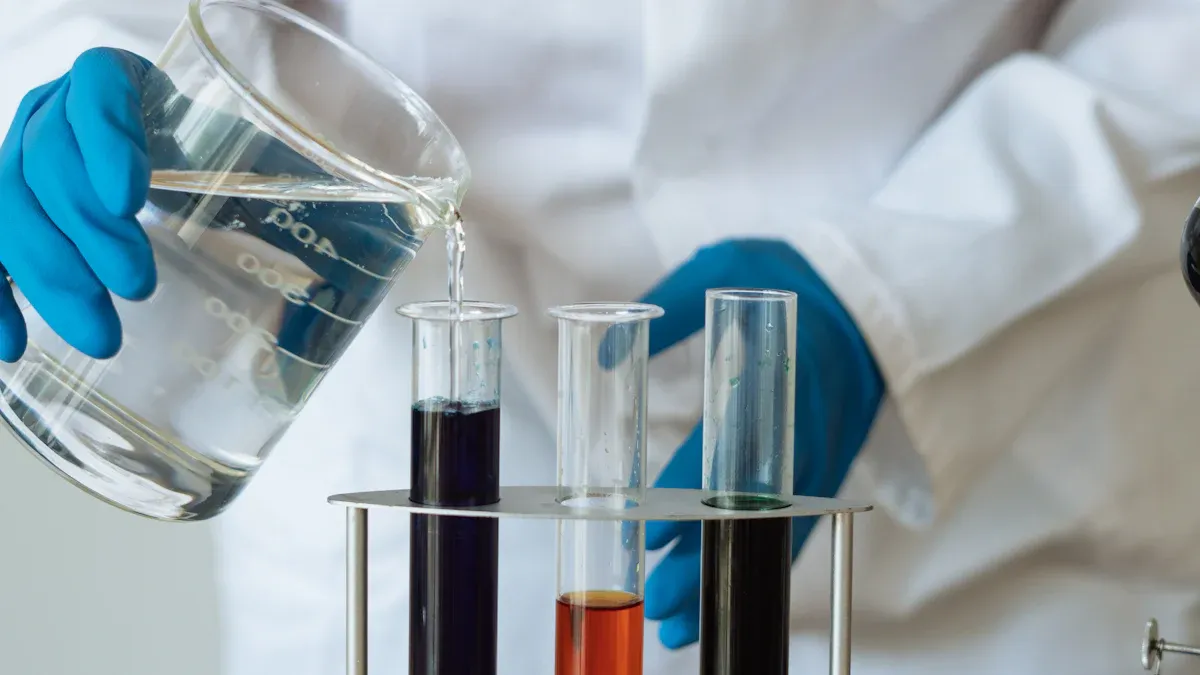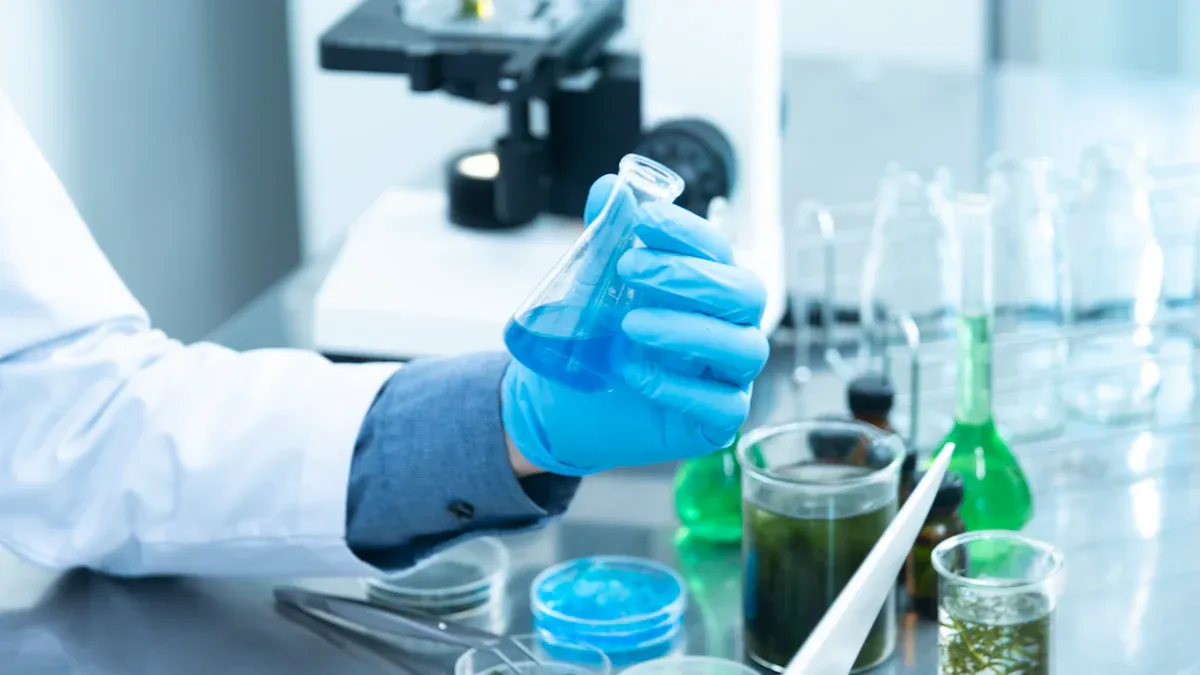
Isobutenyl chloride plays a pivotal role in modern chemistry due to its versatility as a chemical intermediate. Its applications span various industries, including pharmaceuticals, agrochemicals, and dyes. For instance, it assists in synthesizing active pharmaceutical ingredients, enhancing agricultural sustainability through pesticide production, and creating vibrant pigments for textiles. This adaptability underscores its significance in advancing industrial and scientific innovation.
Key Takeaways
- Isobutenyl chloride is a useful chemical used in medicines, farming chemicals, and dyes. This shows its value in today’s chemistry.
- Keeping isobutenyl chloride very pure is important. Purity helps it work well in making drugs and for other uses. Impurities can cause safety problems and make it less effective.
- It is important to handle and store isobutenyl chloride carefully because it can catch fire. Using safety steps can lower dangers in factories.
Overview of Isobutenyl Chloride
Chemical Properties
Isobutenyl chloride exhibits unique chemical properties that make it a valuable compound in modern chemistry. It exists as a liquid under standard conditions and has a boiling point of 68-69ºC. Its density measures 0.883, which is relatively low compared to other organic compounds. The substance is highly flammable, with a flash point of -10ºC, requiring careful handling and storage. Additionally, it reacts violently with strong oxidants and decomposes when burned, releasing potentially hazardous byproducts. These characteristics highlight the compound’s reactivity and the need for stringent safety protocols during its use.
| Property | Value |
|---|---|
| Physical state | Liquid |
| Boiling point | 68-69ºC |
| Flammability | Highly flammable |
| Flash point | -10ºC |
| Density | 0.883 |
| Reactivity | Decomposes on burning, reacts violently with strong oxidants |
The combination of these properties underscores the compound’s versatility in chemical reactions, particularly in industrial and pharmaceutical applications.
Synthesis Methods
The synthesis of isobutenyl chloride involves several established methods, each tailored to specific industrial needs. One common approach utilizes the reaction between isobutene and hydrogen chloride in the presence of a catalyst. This process ensures high yields and efficiency, making it suitable for large-scale production. Another method involves the chlorination of isobutylene, which requires precise control of reaction conditions to prevent the formation of unwanted byproducts. Both methods emphasize the importance of maintaining optimal temperature and pressure to achieve the desired purity and yield.
Advancements in synthetic techniques have also introduced greener alternatives, such as using environmentally friendly catalysts and reducing energy consumption. These innovations aim to minimize the environmental impact of isobutenyl chloride production while maintaining its industrial relevance.
Importance of Purity in Synthesis
Purity plays a critical role in the synthesis and application of isobutenyl chloride. Impurities can significantly affect the compound’s reactivity, leading to undesirable side reactions or reduced efficiency in downstream processes. For instance, in pharmaceutical applications, even trace impurities can compromise the safety and efficacy of the final product. Similarly, in industrial settings, impurities may hinder the performance of catalysts or alter the properties of the end product.
To ensure high purity, manufacturers employ advanced purification techniques, such as distillation and recrystallization. Analytical methods like gas chromatography and mass spectrometry are also used to verify the compound’s composition. These measures not only enhance the reliability of isobutenyl chloride in various applications but also align with regulatory standards for quality and safety.
Applications of Isobutenyl Chloride

Industrial Applications
Isobutenyl chloride serves as a critical intermediate in numerous industrial processes. Its reactivity enables the production of polymers, resins, and specialty chemicals. Manufacturers utilize this compound to synthesize polyisobutylene derivatives, which are essential in creating adhesives, sealants, and lubricants. The compound’s ability to undergo halogenation reactions makes it ideal for producing flame retardants and other safety-enhancing materials.
In the agrochemical sector, isobutenyl chloride contributes to the formulation of pesticides and herbicides. Its chemical structure allows for the creation of active ingredients that target specific pests while minimizing environmental impact. Additionally, industries rely on its versatility to develop dyes and pigments for textiles, ensuring vibrant and long-lasting colors.
Tip: Proper handling and storage of isobutenyl chloride are crucial in industrial settings due to its flammability and reactivity. Implementing stringent safety measures reduces risks and ensures efficient production.
Pharmaceutical Applications
The pharmaceutical industry benefits significantly from the unique properties of isobutenyl chloride. Chemists use this compound to synthesize active pharmaceutical ingredients (APIs) that form the backbone of various medications. Its role as an alkylating agent facilitates the creation of complex molecular structures, which are essential in drug development.
Isobutenyl chloride also plays a role in producing intermediates for antiviral and anticancer drugs. These intermediates serve as building blocks for compounds that inhibit disease progression. The compound’s high reactivity ensures efficient synthesis, reducing production time and costs.
Pharmaceutical manufacturers prioritize purity when using isobutenyl chloride. Impurities can compromise drug efficacy and safety, making advanced purification techniques indispensable. Gas chromatography and mass spectrometry help verify the compound’s composition, ensuring compliance with regulatory standards.
Role in Organic Synthesis
Organic chemists value isobutenyl chloride for its versatility in synthetic pathways. Its ability to introduce alkyl groups into molecules makes it a valuable reagent in alkylation reactions. This functionality enables the creation of complex organic compounds used in various industries.
The compound’s reactivity with nucleophiles allows for the synthesis of esters, ethers, and other functional groups. These reactions are fundamental in developing materials such as surfactants, fragrances, and pharmaceuticals. Isobutenyl chloride also serves as a precursor for halogenated compounds, which are integral to many chemical processes.
Note: The compound’s reactivity requires precise control of reaction conditions. Chemists must monitor temperature, pressure, and catalyst selection to achieve desired outcomes and prevent side reactions.
Isobutenyl chloride remains indispensable in modern chemistry. Its efficient synthesis methods and diverse applications in industrial, pharmaceutical, and organic synthesis highlight its versatility. Chemists continue to explore its potential for innovation, particularly in sustainable practices.
Key Takeaway: Isobutenyl chloride’s adaptability ensures its relevance in advancing chemical processes and addressing future challenges in science and industry.
FAQ
What safety precautions are necessary when handling isobutenyl chloride?
Proper ventilation, flame-resistant storage, and personal protective equipment (PPE) are essential. Avoid contact with strong oxidants and open flames to prevent hazardous reactions.
How does isobutenyl chloride contribute to sustainable chemistry?
Green synthesis methods, such as eco-friendly catalysts and energy-efficient processes, reduce environmental impact. These advancements align with sustainable practices in modern chemical production.
Can isobutenyl chloride be used in small-scale laboratory experiments?
Yes, researchers often use it in controlled environments. However, strict safety protocols and proper equipment are necessary due to its flammability and reactivity.
Post time: Apr-15-2025
